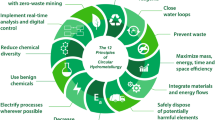Abstract
A one dimensional, nonsteady-state model of the copper waste dump leaching process has been developed which incorporates both chemistry and physics. The model is based upon three equations relating oxygen balance, heat balance, and air convection. It assumes that the dump is composed of an aggregate of rock particles containing nonsulfide copper minerals and the sulfides, chalcopyrite and pyrite. Leaching occurs through chemical and diffusion controlled processes in which pyrite and chalcopyrite are oxidized by ferric ions in the lixiviant. Oxygen, the primary oxidant, is transported into the dump by means of air convection and oxidizes ferrous ion through bacterial catalysis. The heat generated by the oxidation of the sulfides promotes air convection. The model was used to simulate the leaching of copper from a small test dump, and excellent agreement with field measurements was obtained. The model predicts that the most important variables affecting copper recovery from the test dump are dump height, pyrite concentration, copper grade, and lixiviant application rate.
Similar content being viewed by others
References
H. W. Sheffer and L. G. Evans:Bureau of Mines I.C., 1968, no. 8341, 57 pp.
J. A. Harris:Proc. Australian Inst. Mining Met., 1969, no. 230, pp. 81–92.
R. J. Roman, B. R. Benner, and G. W. Becker:SME-AIME Trans., 1974, vol. 256, pp. 247–52.
R. L. Braun, A. E. Lewis and M. E. Wadsworth:Solution Mining Symposium, Chapt. 21, pp. 295–323, American Institute of Mining, Metallurgical and Petroleum Engineers Inc., New York, 1974.
B. W. Madsen, M. E. Wadsworth, and R. D. Groves:SME-AIME Trans., 1975, vol. 258, pp. 69–74.
R. W. Bartlett:Proceedings of the International Symposium on Hydrometallurgy, Chapt. 14, pp. 331–74, American Institute of Mining, Metallurgical and Petroleum Engineers Inc., New York, 1973.
J. D. Lowell and J. M. Guilbert:Econ. Geol., 1970, vol. 65, pp. 373–408.
M. E. Wadsworth: University of Utah, Salt Lake City, Utah, personal communication, 1974.
J. D. Stephens: Kennecott Copper Corporation, Salt Lake City, Utah, personal communication, 1974.
Y. T. Auck and M. E. Wadsworth:Proceedings of the International Symposium on Hydrometallurgy, Chapt. 25, pp. 645–700, American Institute of Mining, Metallurgical and Petroleum Engineers Inc., New York, 1973.
C. T. Mathews and R. G. Robins:Aust. Chem. Eng., 1972, pp. 21–25.
E. E. Smith and K. S. Shumate: Water Pollution Control Research Series 14010 FPS 02/70. U.S. Department of the Interior, Federal Water Wcallty Administration, 1970.
A. E. Lewis and R. L. Braun: UCRL-73284 preprint, Lawrence Livermore Laboratory. January 1972.
Author information
Authors and Affiliations
Additional information
J. A. APPS, formerly a scientist at the Metal Mining Division Research Center, Kennecott Copper Corporation, Salt Lake City, Utah
Rights and permissions
About this article
Cite this article
Cathles, L.M., Apps, J.A. A model of the dump leaching process that incorporates oxygen balance, heat balance, and air convection. Metall Trans B 6, 617–624 (1975). https://doi.org/10.1007/BF02913857
Received:
Issue Date:
DOI: https://doi.org/10.1007/BF02913857




